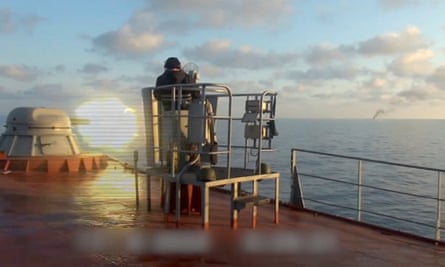Ukraine’s armed forces have claimed to have liberated three frontline villages in western Donetsk, almost a week after the launch of counteroffensive operations.
Soldiers were shown in video footage raising he Ukrainian flag over the village of Blahodatne, south of the town of Velyka Novosilka, one of the main axes of the counteroffensive so far. Troops from another brigade filmed themselves with their unit’s banner in Neskuchne. Later on Sunday, the deputy defence minister Hanna Maliar said a third village, Makarivka, had been taken. It is believed to have fallen on Sunday morning.
“In the areas where our troops are on the defensive, no position was lost,” Maliar said on the Telegram messaging app.
They are the first settlements that the armed forces have officially confirmed as liberated since the start of the counteroffensive a week earlier.
Another settlement further south along the same road, Urozhaine, was being fiercely contested, according to Russian military bloggers.
“By the way, we didn’t move our main forces yet,” a Ukrainian officer texted from the southern front. “So there are grounds to believe in the best.”
“In total, in one week of assault operations around Velyka Novosilka, Ukrainians managed to liberate around 95 sq km of the ground,” a Ukrainian military reporter blogging under the title of Reporting from Ukraine wrote.
The advance south from Velyka Novosilka represents the most significant gains of the counteroffensive to date, but Ukrainian forces still have some way to go before they reach Russia’s main fortified defensive line.
On Sunday, railway lines supplying Russian-occupied Zaporizhzhia region and Crimea were reportedly blown up in two sabotage attacks, one on a railway bridge at Yakimivka in Zaporizhzhia and another in Kirovskoye in Crimea, where a freight locomotive was said to have been damaged.
Along with signs that the counteroffensive was beginning to gain momentum, at least in one area, there was more evidence on Sunday of the rifts in Russia’s military leadership. Yevgeny Prigozhin, the head of the Wagner group mercenary organisation, rejected a move by the defence minister, Sergei Shoigu, to put Wagner fighters under ministry control by ordering all “volunteer detachments” to sign contracts with the ministry by the end of the month.
“Wagner will not sign any contracts with Shoigu,” Prigozhin said.
Across the whole front, progress had been slow and gruelling for the Ukrainians in the first week of the counteroffensive, as Russian soldiers generally held their ground in heavily fortified and mined positions. But military analysts said Kyiv had so far committed a fraction of the 12 brigades it had held in reserve.
The Institute for the Study of War (ISW) said in its daily report on Sunday: “Ukrainian forces are currently attempting an extraordinarily difficult tactical operation – a frontal assault against prepared defensive positions, further complicated by a lack of air superiority – and these initial assaults should not be extrapolated to predict all Ukrainian operations.
“The Russian military remains dangerous and Ukrainian forces certainly face a hard fight, but Ukraine has not yet committed the vast majority of its counteroffensive forces and Russian defences are not uniformly strong along all sectors of the frontline.”
The ISW reported that the area around Velyka Novosilka was one of at least four main directions of Ukrainian attack over the weekend, the others being around Bilohorivka in Luhansk, about 6 miles west of Luhansk city; Bakhmut in northern Donetsk; and western Zaporizhzhia, particularly south of the town of Orikhiv.
On the Black Sea, meanwhile, media in Moscow reported that a Russian naval intelligence collection vessel, the Priazovye, had come under attack from six Ukrainian drone boats while it was on patrol guarding the TurkStream and Blue Stream undersea gas pipelines carrying Russian gas exports to Turkey and Europe. The reports said the Priazovye had been able to repel the attack and video footage posted on social media showed guns being fired from a ship’s deck at small unmanned boats, one of which exploded.

Ukrainian forces are having to pursue the counteroffensive while using some of their resources to help the relief effort in Kherson and Mykolaiv regions, devastated by floods after the destruction of the Nova Kakhovka dam on Tuesday.
Six people are confirmed dead on the Ukrainian-held right bank of the Dnipro river, and the interior minister, Ihor Klymenko, announced on Sunday that there were still 35 people missing, including seven children. Klymenko said 77 towns and villages had been flooded in Kherson and Mykolaiv and that 3,700 people had been evacuated.
There are believed to be far more deaths on the Russian-held left bank of the Dnipro, where many people in submerged towns and villages were left to fend for themselves. Kyiv has demanded the intervention of the international humanitarian agencies.
The UN emergency relief coordinator, Martin Griffiths, said on Friday that his office had been in touch with Russian authorities seeking permission for safe access across the lines. Asked on Sunday if there had been any progress in the discussions, Eri Kaneko, a spokesperson for the UN Office for the Coordination of Humanitarian Affairs, said only: “Efforts continue with both parties to ensure that critical aid can be delivered to the flood-affected areas.”
Kyiv has been coordinating with the UN over relief supplies since the dam’s collapse, and Ukrainians have tried to evacuate people trapped on the left bank, despite coming under fire from Russian positions. In an attack on one boat, three people were reported to have been killed and 10 injured.
Ruslan Strilets, Ukraine’s environmental protection minister, said the dam’s destruction, widely believed to have been an act of sabotage by Russian forces who had control of the hydroelectric station at the site, had deprived 1 million Ukrainians of drinking water.

